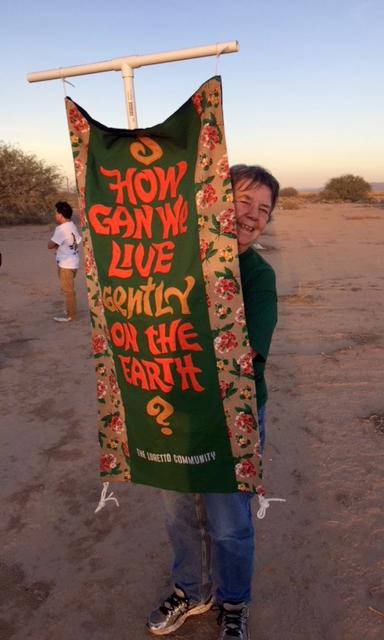
Protesting Operation Streamline at the Federal Courthouse in Tucson, Arizona (Eileen Harrington, CoL)
Two weekends before Thanksgiving, I traveled to Arizona to participate in the School of the Americas Watch protests. SOA Watch organized protests at Fort Benning, Georgia, for 20 years. Two years ago, it moved its focus to the border wall in Arizona.
Many Jesuit colleges had stopped organizing participation for their students at Fort Benning, so the number of protesters had dropped, but also the protests seemed routine and ineffective.
I know we protest because it is the right thing to do, not because it is effective. Nonetheless, we had no access to the base, municipal police hemmed us in, helicopter flyovers disturbed the rally, and permits were difficult to secure. So a move that gave us greater access to sites where injustice occurs made some sense.
The Arizona site, though, is a complex one. The weekend began in Tucson on Friday at the federal courthouse, where undocumented immigrants speed through a hearing, 10 or 20 at a time, pleading guilty together and accepting immediate deportation for a first offense or else some jail time.
We all stood outside the courthouse and heard speeches about the need for immigration reform and sang together our determination to achieve justice.

Loretto Sr. Mary Ann McGivern outside the Eloy Detention Center in Arizona (Eileen Harrington, CoL)
Then around 3 p.m., we drove north for an hour in a caravan to Eloy, a tiny town in the middle of nowhere that houses 1,500 unconvicted men and women at a detention center operated by CoreCivic, formerly Corrections Corporation of America. It is a private prison, with towers, lights and rolls of barbed wire at the top of 20-foot fences.
We had a rally in a field with speeches and music and then, in the dark, we walked down the road to stand against the prison perimeter and chant, "No eres solo" — "You are not alone."
My small group left at about 9 p.m., driving south two hours to Nogales on the border. We checked into our hotel and were up at 7, gathering to pray in the lobby and then join the march to the border. Our Loretto delegation numbered 16. There were 32 high school students from Ohio, and other clusters of five and 10 and 20. All the hotels offered SOA Watch discounts for the weekend.
We stood at the wall for another rally, joined by protesters on the Mexican side.
Back in 1994, when this wall was being finished, President Bill Clinton stood at the Brandenburg Gate in Berlin and said, "We stand together where Europe's heart was cut in half, and we celebrate unity." Clinton didn't come to Nogales and give a speech about building another wall. The sin of the wall goes back many years.
Meanwhile, all-day Friday and Saturday workshops were offered at one of the hotels on topics like closing detention centers, the U.S. arms trade with Latin America, Border Patrol militarization, and offering sanctuary.
SOA Watch was founded because the U.S. trains foreign military troops and the training has been known to undermine democracy. The death squad that murdered environmentalist Berta Cáceres may have included U.S.-trained troops. Justice for Berta was one of the workshops.
Advertisement
Finally, on Sunday morning at the wall, protesters walked in the funeral procession, chanting the names of the dead, many killed by Latin American troops who had been trained by the U.S. military. It is a moving procession. The response to each name is "Presente," meaning that we are standing at the wall with them and for them.
The SOA Watch protests are a call to change public policy, and they are a deeper call to us, the protesters, to open our hearts and minds and to take courage together to act on behalf of the dead. That's the point.
It is a lot of driving, a lot of standing, a lot of walking in the desert sun, a lot of listening to urgent news, all to call us to action on behalf of our suffering brothers and sisters.






